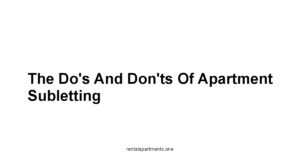Navigating a lease agreement, it’s like charting a course through a legal sea, and understanding key clauses—like those concerning rent, responsibilities, and termination—is not merely advised, it’s essential for a smooth voyage.
Recent data from the National Multifamily Housing Council shows that approximately 43 million U.S.
Households rent their homes, and with such a large figure, the importance of fully understanding a lease contract cannot be understated, it is the foundation of your rights and responsibilities during your tenancy, and failing to know it is akin to sailing without a map.
Landlords, the property owners, and tenants, the residents, both have duties under the lease, such as the landlord maintaining structural integrity and you ensuring rent is paid punctually, but this two-way street works best when clearly defined in the contract, for example, repair responsibilities usually fall to the landlord for major issues, and tenants handle minor upkeep.
The property’s specifics, from the exact address to the included amenities like parking or gym access, must be crystal clear, because the lease term, detailing the start and end dates, is not a suggestion but a binding commitment.
It’s not just rent either, the security deposit, late fee protocols and potential rent increases, must all be known before your signature touches the paper, and the methods and timelines are a big deal, late fees, for example, can add significant, unnecessary expense.
Understanding financial obligations is your shield, so understand your lease. Here’s a quick look:
- Parties Involved: Landlord property owner and tenant resident.
- Property: Address, unit number, amenities.
- Lease Term: Start and end dates, duration.
- Rent Payments: Monthly amount, due date, payment methods.
- Security Deposit: Amount, purpose, refund process.
- Late Fees: Fee amount, when it applies, grace periods.
- Rent Increases: Frequency, notice period, limits.
- Utilities: Who pays for what electricity, water, gas, internet
- Maintenance & Repairs: Landlord vs. tenant responsibilities.
Your rights matter, so grasp them, and the ‘quiet enjoyment’ clause isn’t just legal jargon, it guarantees peace and privacy, but alterations, subleasing, and pet rules are not suggestions either, all these are a part of the agreement and if you break it, you are breaking the contract. Then there’s the end, leases don’t last forever.
Termination clauses, notice periods, and renewal options, they dictate the end game and understanding how to navigate them is critical, and of course, always leave the property in good condition to avoid disputes.
Important aspects you might encounter:
- Use of Premises: How you can legally utilize the property.
- Quiet Enjoyment: Your right to peace and privacy.
- Default & Remedies: What happens if terms are breached
- Insurance: Required coverage for your protection.
- Assignment Clause: Transferring the lease to someone else.
- Indemnification: Liability for damages.
- Governing Law: Which state’s laws apply.
- Entire Agreement: The written lease is the full contract.
A lease, it’s not something to skim over, it’s a detailed map of your living situation, a crucial document requiring your full attention and when you approach it with awareness, you’ll avoid many potential issues and live in peace.
Decoding the Lease: What You’re Really Signing

A lease, it’s a contract.
A simple piece of paper, maybe, but it holds a lot of power.
It sets the stage for where you’ll live, how you’ll live, and what you’re responsible for. It’s not something to skim over.
You need to know the details, like knowing the course before setting sail, or you’ll get lost.
This document, it’s the law between you and the landlord.
It dictates everything, from the roof over your head to the money leaving your pocket. You have to understand it.
This lease, it isn’t just a formality. It’s the rules of engagement.
You have to know your opponent, and in this case, your opponent is the contract itself.
Know its strengths, its weaknesses, the escape hatches, and the pitfalls.
A lease well understood is a peaceful time in your home. It’s better to be prepared than surprised.
And trust me, surprises in a lease agreement aren’t usually good ones.
So, let’s break it down, piece by piece, so there are no surprises, no misunderstandings.
The Parties Involved: Landlord and Tenant, Defined
The landlord, they own the property. They provide you with shelter.
And the tenant, that’s you, that’s me, that’s anyone who’s renting.
It’s important to know who’s who, the roles you both play. The lease should spell it out clearly. No confusion. No gray areas.
- The Landlord: They might be an individual, a corporation, a management company. It could be anyone really. It’s important to know who has the authority and who you need to contact for repairs, questions, and issues. Make sure the contact information is correct. Check it, double check it. And don’t forget a name or two.
- The Tenant: It’s not just the main renter who’s responsible. Anyone named on the lease is equally bound by it. All the tenants, they share the burden. All the tenants, they share the rights. Everyone listed is in the same boat. No one gets a free pass. If one tenant fails, it impacts them all.
A table showing how responsibilities are split would look something like this:
| Responsibility | Landlord | Tenant |
|---|---|---|
| Property Ownership | Yes | No |
| Rent Payment | No | Yes |
| Repairs Major | Yes | Usually No |
| Routine Maintenance | Usually No | Yes |
| Adherence to Lease | Yes Indirectly | Yes |
| Property Access | Limited with notice | Full within lease terms |
The Property: Location and Specifics Matter
The address, the unit number, the layout, they all matter.
There shouldn’t be any ambiguity about where you will live. Don’t sign a lease for something you haven’t seen. Look at the apartment. Walk through it. Open the windows. Turn on the lights.
Make sure it’s what you expect and the lease matches the actual unit.
- Exact Address: The street number, the apartment number, the city, the state, the zip code. Every detail matters. If it isn’t correct on the lease, get it fixed. If they put the wrong apartment on it, or the wrong number, it can be problematic. If it is different from what you’ve discussed, you’ll want to know and fix it.
- Unit Description: The number of bedrooms, the number of bathrooms, the floor of the apartment building. The things you rely on in your daily life. It matters, especially if it’s different from what you were promised. It matters if they call it a two bedroom and it only has one. You pay for what they promise.
- Included Amenities: Parking spots, storage units, access to a pool or gym. These are often key factors. It needs to be in writing. Never just accept what they say orally. Write it down. Put it in the contract. If they aren’t there, you can argue it. If it isn’t written in the contract, you can not.
Lease Term: Start and End Dates, Crucial Details
The lease, it isn’t forever, unless they say so. It has a start date and an end date. Know these dates. Mark them on your calendar.
You’re obligated from the first day to the last and if you stay after that, there are penalties involved. Missing them can be costly. So, pay attention to it.
- Start Date: This is when your legal obligation begins. It’s also the day you can move in. This is what starts your lease. This is where you start paying. You have a lease and responsibilities on this date.
- End Date: This is the day your lease ends. The date you must vacate the premises or you may be in violation of the lease. You will either need to move or renew. This is not always the end of a month or the end of a billing period.
- Lease Duration: The length of your lease, it’s important for planning. Usually it’s a year, but it can be longer or shorter. A six-month lease? Two years? It’s good to know in advance. It all depends on the term listed. Pay attention to this.
Rent Payments: How Much, When, and How
Rent, it’s the price you pay to live in the property. It’s the primary obligation.
Knowing how much, when it’s due, and how to pay it, it is critical. It has to be in the lease, clear as day. No guessing.
No hoping they send you an invoice, because you agreed to pay.
- Monthly Rent Amount: The specific dollar amount you pay each month. Not an estimate. Not a vague approximation. The exact amount. Make sure it’s correct.
- Due Date: Usually, it’s the first of the month. It can be any day, though. Look closely. If it’s the second, then that’s what you will follow. The due date is important because after that, late fees apply. If you get paid on the 5th, you need to arrange it to ensure the rent is paid on the due date, not on the day you’re paid.
- Payment Methods: Cash, check, online portals, whatever is accepted. See what works best and make sure it’s available. They may only accept checks or cash, and you have to ensure you can meet the need. Some places don’t accept cash, only online.
Here’s a hypothetical example of how rent payment might be structured in a lease:
| Element | Detail |
|---|---|
| Monthly Rent | $1,500.00 |
| Due Date | First of Each Month |
| Late Fee | $50 after 5th of the Month |
| Payment Methods | Online Portal, Check, Money Order |
| Grace Period | None |
Navigating the Financial Obligations in a Lease
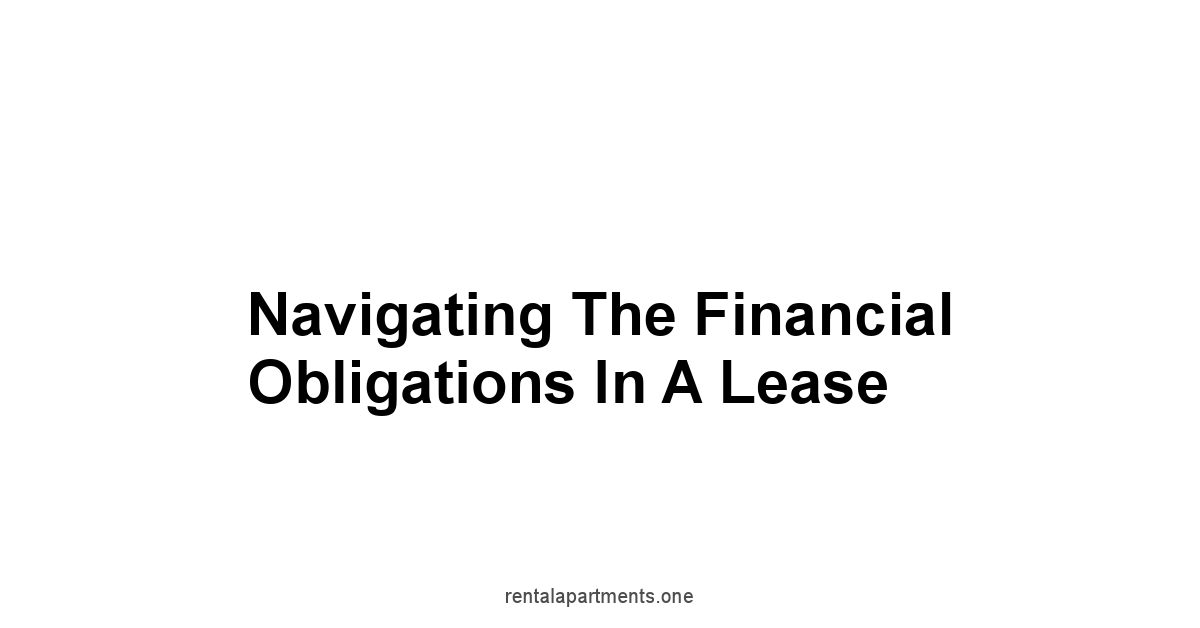
A lease, it’s more than just rent. There are other financial obligations.
Security deposits, late fees, potential rent increases. It’s good to know them ahead of time.
These things, they affect your wallet, so pay attention.
They can really make or break a budget if you aren’t paying attention.
The financial part, it’s critical to understand.
It’s the money side of things, the reason people rent out properties. But you have to understand it too.
You have to understand how it is going to affect your expenses. Be prepared.
Security Deposits: What It Is and How It’s Used
The security deposit, it’s a safety net for the landlord. It’s there to cover damages. It’s not free money for them to spend. They have to return it if there’s no damage. But you have to make sure that is the case.
If you damage something, they can use this deposit.
- Amount: The specific dollar amount of your deposit. It should be clearly stated. It may be one month’s rent, it might be a half month. It depends on the lease. Don’t assume.
- Purpose: It’s there to cover unpaid rent or damages to the property that aren’t considered normal wear and tear. They use it if you scratch the floors, break a window, or don’t pay the rent.
- Refund Process: You should get the deposit back after you move out, minus any deductions for damage. It may take some time. But they have a period of time in which to send it back. The lease will state the time period as well as what they need to return it. If they don’t return it, they have to tell you why.
- State Laws: Some states limit how much a landlord can charge for a deposit, and how long they have to return it. Know the rules in your state. If they violate them, you have rights.
Here’s a breakdown of how a security deposit might be handled:
| Aspect | Detail |
|---|---|
| Deposit Amount | $1,500.00 |
| Allowed Deductions | Damages beyond Normal Wear and Tear, Unpaid Rent |
| Refund Timeline | 30 days after Move-Out |
| Itemized List | Required for all deductions |
Late Fees: Avoid Them, Understand the Rules
Late fees, they’re penalties for not paying rent on time. Avoid them if you can. It’s an easy way to lose money. It’s an unnecessary cost that is easily avoidable.
- Fee Amount: It should be a specific amount, like $25 or $50. It may also be a percentage of the rent due. It will depend on the state and the contract. But it will be detailed.
- When They Apply: Late fees might kick in the day after the rent is due or after a short grace period. Know this period. If it’s 24 hours, you have to pay on that day. If you pay it the next, you are charged a fee.
- State Limits: Many states have laws that regulate the amount of late fees a landlord can charge. Make sure you know your state’s rules, it’s important to know the state law and the lease terms.
Rent Increases: What to Expect and When
Rent increases, they happen. It’s a reality.
Your lease should explain if and when it might go up. It needs to be in writing. You’ll have to plan for this.
- Frequency: How often rent can be increased yearly, for example. It is not always clear cut. There are rules that need to be followed. It’s not something they can change on a whim. It has to be done based on the lease and local laws.
- Notice: How much notice they have to give you before a rent increase. Usually it’s 30 days, or more. There are laws regarding this notice. Ensure you get proper notice, so you can plan accordingly.
- Limits: Some areas have rent control laws that limit how much a landlord can raise rent. Know the local laws and how they may affect your rent. You can be prepared for it.
Utilities: Who Pays and For What
Utilities, it’s electricity, water, gas, internet, and more. The lease should specify who pays for them. It’s usually the tenant, but not always. It’s important to know this.
- Tenant Responsibilities: If you’re responsible for utilities, know the process of setting up accounts. Do it before you move in. It can take time. If you wait, you will not have power when you move in, and that can be a big problem.
- Landlord Responsibilities: If the landlord covers any utilities, make sure it’s detailed. What is covered, and what isn’t. If they cover water and trash, but not gas, you need to know that.
- Shared Utilities: In some multi-unit properties, utilities might be shared. Know how the cost is allocated. If you share water, be aware of what your neighbor does. If they have a giant pool that they fill, it will impact your bill.
A quick table of who is typically responsible for various utilities:
| Utility | Typically Paid By | Possible Variations |
|---|---|---|
| Electricity | Tenant | Landlord in some cases |
| Water | Tenant | Landlord in some apartments |
| Gas | Tenant | Landlord in some apartments |
| Trash Removal | Tenant | Included in rent |
| Internet | Tenant | Can be included in rent |
| Cable/Satellite | Tenant | Optional/Paid by tenant |
Understanding Your Rights and Responsibilities
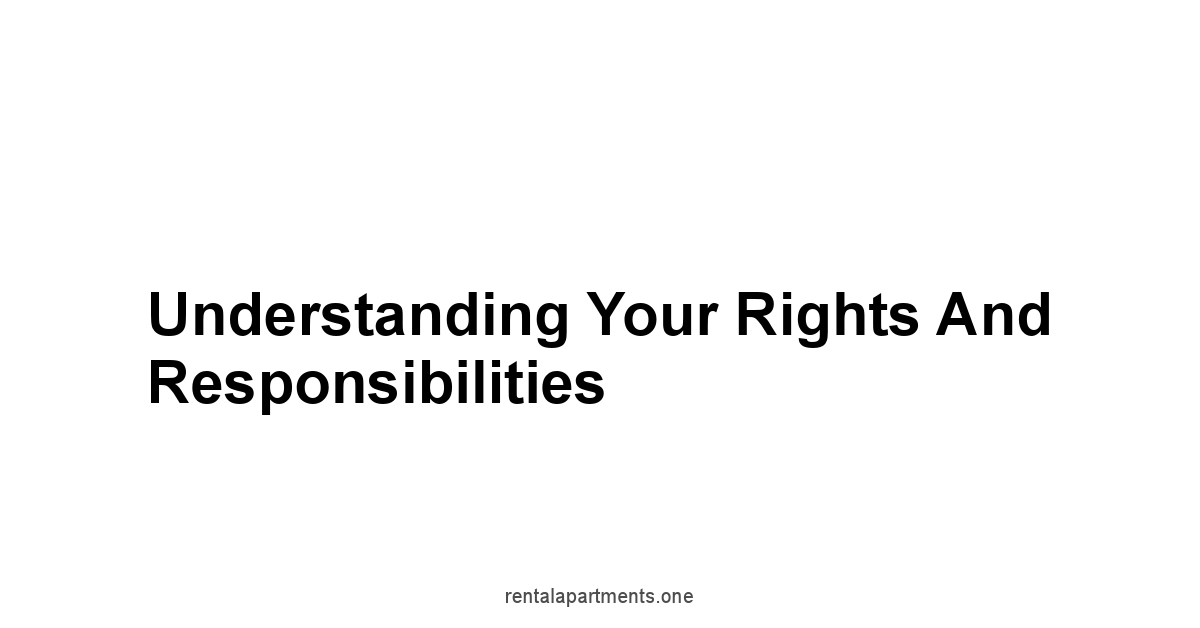
A lease, it’s a two-way street. You have rights, and you have responsibilities. It’s important to know what they are. They go hand in hand, and you can’t ignore them. Know these details, protect yourself. Ignorance is no excuse.
You are not just a tenant. You are an equal in this agreement. You have rights just like the owner. Know what they are. Ensure you get what you deserve. You have to protect yourself.
Maintenance and Repairs: Who’s Responsible For What
Maintenance, it’s the upkeep of the property. Repairs are for things that break. The lease must detail who is in charge of what. Be clear on these details.
The last thing you want to do is wait for someone to make a repair. Especially if it’s something important.
- Landlord’s Responsibilities: Major repairs, like a broken water heater, are typically on them. Things you cannot do on your own. These are major repairs. These take specialized people, and this is why the landlord is responsible for them.
- Tenant’s Responsibilities: Minor upkeep, like changing light bulbs, it’s usually on you. The things you are capable of. You have to do your part. If you aren’t sure, be sure to ask.
- Reporting Issues: Know how to report problems to your landlord. Call them, email them, text them. Whatever works. But keep a record of it. You have to tell them what’s broken. If you don’t they may blame you.
- Timeframe for Repairs: Landlords generally have a reasonable time to make repairs. Some state laws dictate the time frame. Check them out. You can’t wait months, sometimes it should only be days.
Alterations to the Property: Get Permission First
Alterations, it’s making changes to the property. Painting, hanging shelves, changing the fixtures. You usually need permission for these things.
Don’t just change things, it may cause you a lot of trouble later.
- What’s Allowed: The lease should specify what changes you can make without permission. Some things may be obvious. Others aren’t. You have to know.
- How to Get Permission: If you want to paint a wall, you might need to get it in writing. Do not just get a verbal agreement. This can cause you problems when you are trying to move out.
- Restoration: When you move out, you might have to return the property to its original state. This is common. If you painted the room pink, and it was a neutral color, you have to repaint it back to the original color before leaving, or you might be charged to have them do it.
Subleasing: Know Your Rights and Restrictions
Subleasing, it’s letting someone else rent your place.
It’s usually not allowed unless there is permission. The lease will detail the rules around this. Be clear on this detail.
- Lease Clauses: Some leases forbid subleasing. Read the details. Don’t assume it’s okay. If it’s not in the lease, you should consider not doing it. Because if it isn’t, you are breaking the contract.
- Landlord Permission: You need permission from the landlord if subleasing is allowed. You can not just decide to rent out your place and make a profit without their permission.
- Liability: Even if you sublease, you are still responsible for the lease terms. If your subtenant damages the property, it’s still your responsibility. You aren’t off the hook just because you subleased.
Pets: Rules and Regulations, Read Them Carefully
Pets, they can be a source of comfort. But leases often have rules about them.
Know the restrictions before you move in with your furry friends.
The last thing you want to do is get into trouble with your landlord because you have a dog.
- Pet Policy: Some leases ban pets outright, others may allow them with fees or restrictions. Know these details. If they don’t allow pets and you move one in, you will have problems.
- Pet Fees: The amount you must pay for your pet, usually a one-time fee or monthly rent. It’s very important to know. Some places charge $50 a month, others $500.
- Breed Restrictions: Some breeds of dogs may not be allowed. Be aware of this. If you are renting an apartment that restricts certain breeds, be sure to check their list. If your dog is on the list, you’ll have to find a new place for you and him.
- Number of Pets: You may be limited on how many pets you can have. Don’t go over this. If the lease says one, you can’t have 2.

Here’s a simple table summarizing tenant and landlord responsibilities:
| Responsibility | Landlord | Tenant |
|---|---|---|
| Major Repairs | Responsible for fixing major issues e.g., broken appliances, plumbing, heating | Report issues promptly |
| Minor Maintenance | Not typically responsible | Maintain the cleanliness of their unit, replace lightbulbs, maintain smoke detector batteries |
| Property Safety | Ensure building meets safety and health standards. | Ensure property is secure and report issues immediately |
| Alterations | Must grant permission for any changes before work is started. | Must ask for permission before making changes. Must agree to restore to original condition upon move-out |
| Subleasing | Determine whether subleasing is permitted. | Must seek written permission before subleasing to anyone |
| Pet Policy | Sets and enforces rules for any pets allowed | Must follow all policies on pets, ensure vaccinations are up to date and abide all restrictions |
Lease Termination: Ending the Agreement
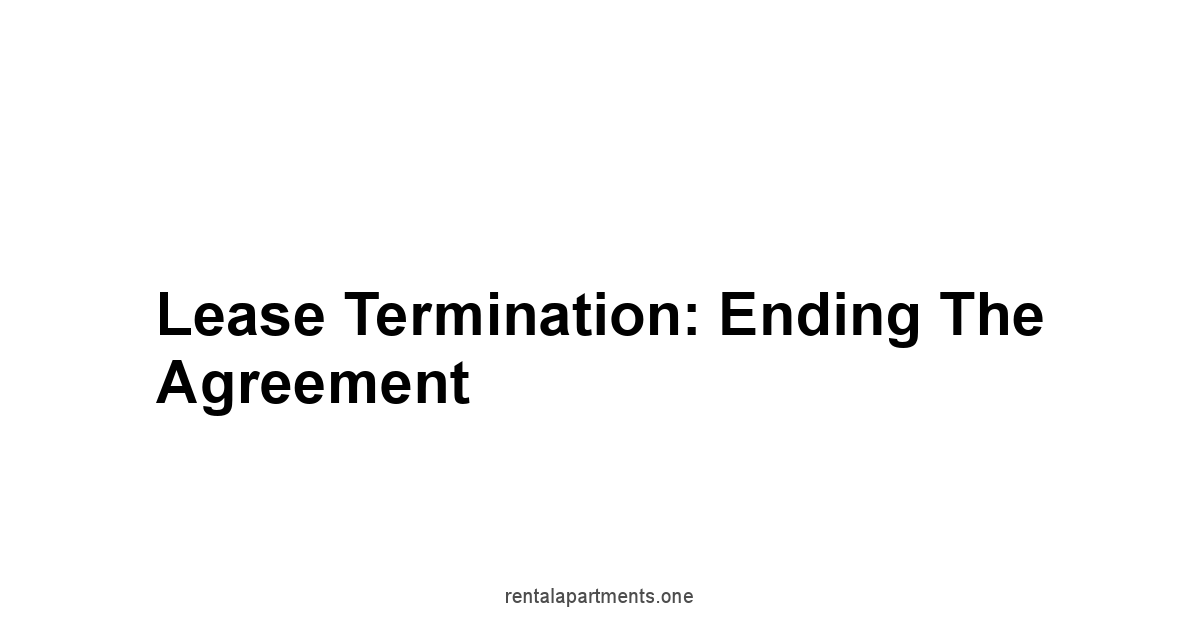
The lease, it ends. You have to know how to end it right. There are rules and procedures. It’s all in the contract. The lease isn’t a forever contract.
It has an end date, and it’s important to understand what happens then.
Ending it isn’t simple.
You have to follow the guidelines, you have to do the right thing.
You have to know the steps, or you could end up in a bad situation. Protect yourself with knowledge.
Notice Periods: How Much Time is Required
Notice, it’s telling the landlord you’re leaving. You have to do it ahead of time. Not the day before. Not the day of. It’s in the lease how much notice is needed. It may be 30 days, it may be 60 days. It’s important to know that.
- Timeframe: The standard notice is 30 days or 60 days. Some leases require more time. It depends on the lease. Make sure you look at it. If it says 90 days, you have to give them 90 days notice.
- Form of Notice: Usually, it’s in writing. It may also be in electronic form. You have to know the process for it. If they require a written notice, make sure you provide one. If you can email it, that may be the best way to do it.
- Consequences of Not Giving Notice: Failing to give proper notice could mean losing your security deposit or additional fees. This is a real problem. If they can charge you for it, they will.
Early Termination: Penalties and Consequences
Early termination, it’s breaking the lease. It means you’re leaving before the end date. It’s expensive. There are penalties. Avoid it if possible. It’s a big problem.
- Lease Break Fees: Many leases have early termination clauses. They detail the fees you have to pay. It may be one month’s rent, it may be more. Know this detail.
- Responsibility for Rent: You might be responsible for the rent until a new tenant is found. Don’t just expect that they are going to find a new tenant right away. They may take their time. And you still have to pay.
- Exceptions: Some situations, like job loss or unsafe conditions, may allow for early termination without penalty. You have to investigate these loopholes. But they don’t always exist.
Renewal Options: Negotiate or Move On
Renewal, it’s signing a new lease, staying longer. You have to decide if you want to renew or move on. Make sure you do not wait for the last minute. Plan ahead.
- Notice Period: The lease might require you to tell the landlord if you want to renew. It may be 60 days before the lease is up.
- Negotiation: You can negotiate the new lease terms, including rent. This is not always an option. But it’s worth a try. You may be able to get a better price or a better contract.
- Moving Out: If you don’t renew, you have to plan for your move. It’s best to start early. It is also best to let them know you aren’t going to renew as early as possible.
Moving Out: Leaving the Property in Good Condition
Moving out, it’s not just packing your boxes.
You have to leave the property clean and in good condition. You may have to fix things, too. It’s important to protect your deposit.
- Cleaning Requirements: You may be required to clean the property before you leave. Vacuum, sweep, and dust. They may even require the carpets to be professionally cleaned.
- Damage Assessment: Do a final walk-through with the landlord to check for damage. Do this with the landlord, so they cannot make changes later, and you can both be in agreement.
- Forwarding Address: Leave a forwarding address with the landlord to receive your security deposit refund. Do not forget this. Otherwise they may not send it.
Here’s a table of the key aspects related to ending a lease:
| Aspect | Detail |
|---|---|
| Notice Period | Usually 30-60 days before lease end, or according to what the lease states |
| Early Termination | Penalties likely involved, such as losing security deposit, paying for remaining lease, some exceptions may apply if specified |
| Renewal | Notify landlord of intent to renew or not, ability to negotiate terms, plan your move accordingly |
| Move-Out | Leave property clean and in good condition, schedule final inspection, give your forwarding address |
Important Clauses to Review Closely
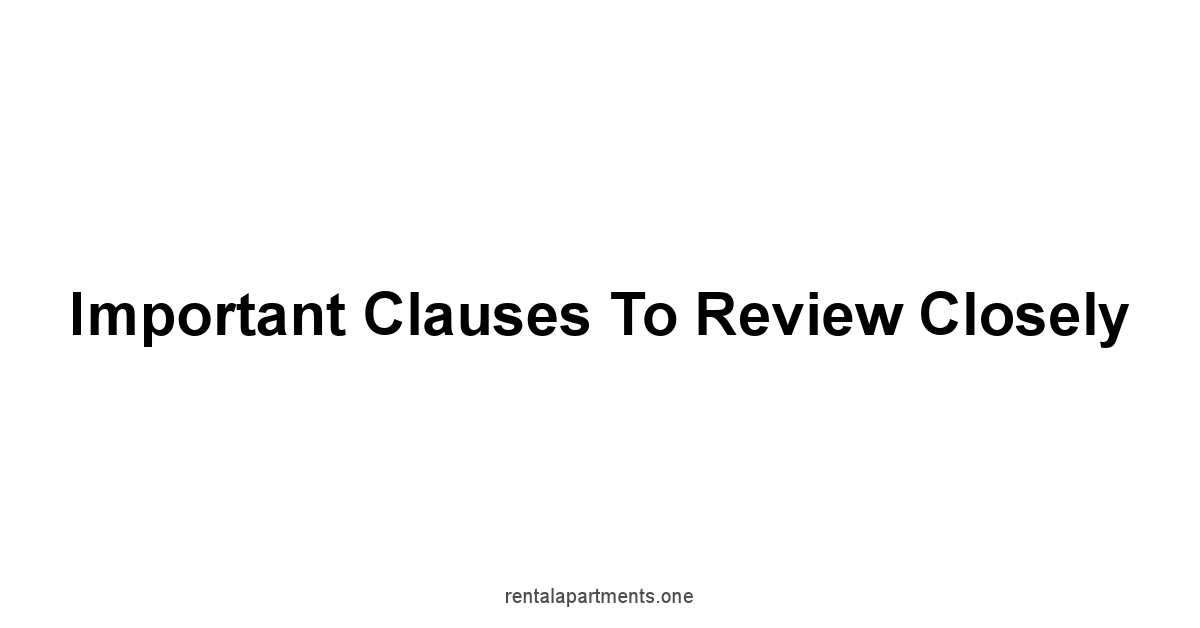
A lease, it has clauses that matter more than others.
These are the ones that can affect your daily life, your rights. Pay attention to these closely. Don’t skim over them. Read them with intent, not casually.
There are parts of the lease that are more important than others. They’re not always easy to spot. They require a second look, a careful examination. It’s not something you should glance at. You have to really look at them.
The Use of Premises: What’s Allowed and What’s Not
This clause, it specifies how you can use the property. It’s not just for living.
It can include rules about home businesses or other restrictions.
You can’t operate a loud business out of your apartment if the contract prohibits that.
- Residential Use: Usually, you can only use the property for residential purposes. You cannot use it to run a store, or run a daycare. It’s not built for those purposes.
- Commercial Activities: Running a business from home may be prohibited or require permission. If it’s not allowed in the lease, don’t do it. You have to follow the rules.
- Number of Occupants: There may be limits on how many people can live in the property. There are usually laws about this, but the lease also can specify that. You can’t have ten people in a one bedroom apartment.
Quiet Enjoyment: Your Right to Peace and Privacy
Quiet enjoyment, it’s your right to peace and privacy in your home.
It means the landlord cannot enter your property without a valid reason and notice. This is a very important clause.
- Landlord’s Access: The landlord can’t just walk into your place whenever they want. They usually need to provide notice first. Usually 24 hours or more.
- Reasonable Notice: What is considered reasonable notice may vary by location. The laws vary by area, but most landlords have to provide it.
- Disruptions: You have the right to a peaceful living environment. You can’t have other tenants disturbing you all the time. It’s important to have peace and quiet.
Default and Remedies: What Happens if Someone Breaches the Lease
Default, it’s failing to meet your lease obligations.
It could be not paying rent or damaging the property. The lease specifies what happens if this occurs. It’s a very important clause. It shows what happens if something goes wrong.
- Landlord’s Rights: The landlord can take action to evict a tenant for a breach of contract. If you violate the terms, they can start an eviction process. They also can charge you fees.
- Tenant’s Rights: The lease also outlines a tenant’s rights if the landlord breaches the contract. You can take legal action if they fail to keep their obligations.
- Legal Procedures: The lease may detail the legal process for dealing with a breach. It may say where you can take a legal case if needed.
Insurance Requirements: Protect Yourself and the Property
Insurance, it’s protection.
Landlords may require tenants to have renter’s insurance.
This protects your stuff and can sometimes help in the case of an accident. Protect yourself.
- Required Coverage: Some leases mandate a certain amount of renter’s insurance coverage. You have to abide by this. You may need to provide them with a copy of your insurance as proof.
- Liability: Renter’s insurance can cover liability in case of an accident. If someone is injured in your apartment, it might help you. It is important to look into.
- Landlord’s Insurance: A landlord’s insurance protects the building. Not your personal property. It’s important to know the difference.
Here’s a summary of these crucial clauses:
| Clause | Description |
|---|---|
| Use of Premises | Specifies how the property can be used residential only, business restrictions, number of occupants |
| Quiet Enjoyment | Guarantees your right to peace and privacy, dictates when landlord can access the property |
| Default and Remedies | Explains consequences of failing to meet lease obligations by tenant or landlord |
| Insurance Requirements | Usually includes tenant insurance requirements and liability protections. It may also cover other items as well |
Additional Clauses You Might Encounter
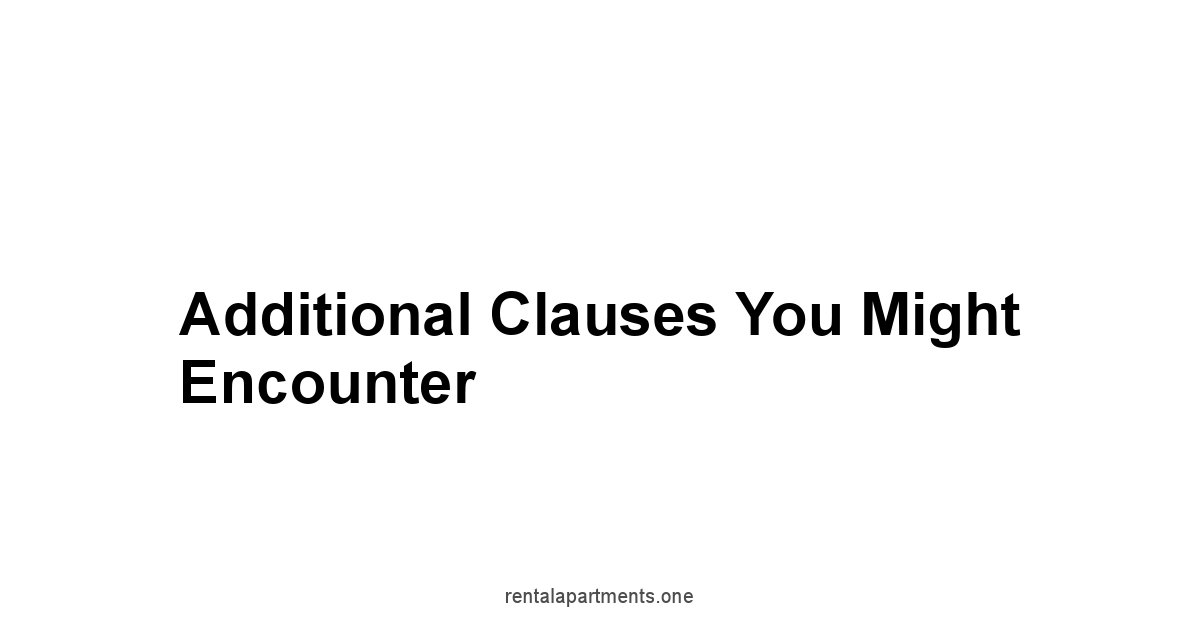
There are other clauses in a lease that you might find. It’s good to know what they are.
Even if you don’t see them in your lease, you might see them elsewhere. Be prepared. Be aware. Be knowledgeable.
These additional clauses, they might not always appear. They’re still good to know about though. You should be aware of these possibilities.
It’s good to be prepared and be on the lookout for them.
Assignment Clause: Transferring the Lease
Assignment, it’s transferring your lease to someone else. It’s not the same as subleasing. This can happen in certain situations. It’s not something you can always do. It’s not a simple task.
- Allowed or Prohibited: Some leases prohibit assignment. Others may allow it with permission. Make sure you look for this clause.
- Landlord Approval: You usually need landlord approval to transfer a lease. You can’t just pick someone else to take your place without permission.
- Liability: You may still be liable for the lease if you assign it. Even after transferring it to someone else, you might still be in trouble if they don’t pay.
Indemnification Clause: Liability and Responsibility
Indemnification, it’s a promise to protect someone from loss or damages. It can specify who is responsible for what. It’s very important to pay attention to.
This clause will specify who has to cover the cost.
- Tenant Responsibility: You might be responsible for damage caused by your actions. If you break something, you are responsible.
- Landlord Responsibility: The landlord may be responsible for damage that is not caused by you. If something breaks on its own, they should be responsible.
- Legal Costs: This clause can determine who pays for legal costs. If you are taken to court, who pays for the lawyers? This will answer it.
Governing Law: Which Jurisdiction Applies
Governing law, it specifies which state’s laws apply to the lease.
It’s usually the state where the property is located. You have to know this.
If you don’t, you might go to the wrong court if there is an issue.
- State Laws: This clause can be important if you move out of state and have a dispute. Which state will handle the dispute? This clause will spell it out.
- Local Ordinances: It may specify if local ordinances are part of the agreement. Know the local ordinances as well as the state laws. They both may apply to the property.
- Court Location: If you have to go to court, it might specify where you have to go. You may not be able to bring a case in any court you want.
Entire Agreement Clause: The Lease is the Complete Contract
Entire agreement clause, it means the lease is the whole agreement. It is the only contract. It’s the only thing that matters. Anything said outside of the lease does not apply. Pay attention to that.
- No Outside Agreements: Any verbal agreements are not part of the lease. Only what is in the lease matters. If they promised you something orally, and it isn’t in the lease, it does not matter.
- Everything in Writing: If it’s not in the lease, it’s not part of the agreement. Make sure to put anything important in writing. Don’t rely on a verbal contract.
- Final Word: The lease is the final word. All previous agreements, they don’t matter. This is the only thing that matters.
Here’s a table summarizing these other lease clauses:
| Clause | Description |
|---|---|
| Assignment | Describes conditions under which a tenant can transfer the lease to another person |
| Indemnification | Outlines who is responsible for damages, liabilities, and legal costs resulting from lease agreement |
| Governing Law | Specifies which state’s laws apply to the lease agreement, including any relevant local ordinances |
| Entire Agreement | States that the written lease agreement represents the complete understanding between landlord and tenant, and no verbal agreements apply. |
Final Verdict
A lease, it’s more than just words on paper.
It’s the foundation of your living arrangement, a contract that dictates not just your rent, but your rights, responsibilities, and peace of mind.
Understanding every clause, every detail, is crucial for a smooth tenancy.
It’s not about being confrontational, but about being informed.
Like a seasoned traveler reading a map, you navigate this document with precision and avoid getting lost in the fine print.
A well-understood lease is your shield against potential disputes.
It allows for a good experience for you in your home.
The financial aspects of your lease, they aren’t just numbers, they’re the heart of your budget, it’s the rhythm to how you pay your bills.
Security deposits, late fees, rent hikes, they all impact your wallet. According to the U.S.
Census Bureau, the median gross rent in the United States was around $1,300 in 2021. Knowing how these figures work, how they impact you, is not only practical, but also protects your financial well-being.
It’s about taking control of your money, not being controlled by it.
A clear understanding of your financial responsibilities ensures you’re not caught off guard.
Your lease also lays down the rules for how you can live in your home.
Maintenance and repairs, they are not suggestions, but obligations.
Alterations, subleasing, pets, these are all areas that need clarity.
It’s like setting the rules of a game before you play, to ensure fairness and avoid chaos.
Understanding these rules ensures you don’t inadvertently break the terms of your lease.
It prevents a lot of heartache and potential legal issues down the line. Know your place, in all senses of the word. It makes for a happy home.
And finally, lease termination is not just about moving out.
It’s about fulfilling your obligations, handling the end of a contract with care and attention to detail.
The notice period, early termination fees, all of these things require your attention.
It’s like making a smooth landing after a long journey.
You need to be precise, follow the procedures, and leave things in good order.
A well-managed lease termination is a sign of respect, for yourself and for your home.
It ensures you leave on good terms, ready for the next chapter.
Frequently Asked Questions
What is a lease agreement and why is it important?
A lease, it’s a contract between you and the landlord.
It’s important because it dictates the terms of your tenancy, what you can and can’t do, and how much rent you pay.
You have to understand it, or you will have problems.
Who are the parties involved in a lease agreement?
The landlord, they own the property. And the tenant, that’s you.
Both have responsibilities and rights under the lease. It’s not one sided, both have to abide by it.
What does the “property” section of the lease cover?
The property section, it spells out the exact address, the unit number, and any included amenities.
You have to make sure the address is right, or it may be on the wrong apartment.
What are the key things to know about the “lease term”?
The lease term, it states the start date, the end date, and the total length of your rental period. Mark it on your calendar.
If you don’t you may over stay and be charged extra.
How should rent payments be detailed in the lease?
The lease, it should clearly state the monthly rent amount, when it’s due, and how you can pay it. They can not change it on a whim. It has to be in writing.
What is a security deposit and how is it used?
The security deposit, it’s a safety net for the landlord.
It covers damages or unpaid rent, not normal wear and tear.
If you break something they will use the deposit to fix it.
What are late fees and how can I avoid them?
Late fees, they’re penalties for not paying rent on time. Avoid them by paying on time. If it’s due the 1st, pay on the 1st. Not the 2nd.
Can rent increase during my lease term?
Rent increases, they can happen, but your lease should specify when and how. Usually it’s when you renew. They have to give you notice.
What are my responsibilities regarding utilities?
The lease, it says who pays for what.
It might be you, it might be the landlord, or you may share the cost. You have to know it before you move in.
Who is responsible for maintenance and repairs?
The landlord, they are usually responsible for major repairs. You, the tenant, are responsible for minor upkeep. If it’s a large repair, call the landlord. If it’s something you can handle, you should.
Can I make alterations to the property?
Alterations, like painting or hanging shelves, usually require permission. Get permission in writing. If you don’t you may have to pay to fix it.
What is subleasing and am I allowed to do it?
Subleasing, it’s letting someone else rent your place. It may not be allowed. Check the lease. If it isn’t in there, you might get into trouble.
Are there rules about pets?
Pets, they can come with rules. Some places ban them. Some places allow them with fees or restrictions. Make sure you know before you get one.
How do I properly terminate my lease?
To terminate a lease, you need to give proper notice, usually 30 or 60 days, as specified in the lease. If you don’t you will pay fees.
What happens if I break the lease early?
Breaking a lease, it can come with penalties.
You may have to pay rent until they find a new tenant, plus some fees. If you can avoid it, you should.
What should I do when moving out to ensure I get my deposit back?
When moving out, leave the property clean, fix any damages, and provide a forwarding address.
Do a final walk through with the landlord before you leave.
What is the “use of premises” clause about?
The “use of premises” clause, it spells out what you can use the property for, not for operating a business unless the lease allows it. It usually means just for living purposes.
What is “quiet enjoyment” and why is it important?
“Quiet enjoyment,” it guarantees your right to peace and privacy in your home. The landlord can’t just barge in. They need to notify you before they enter.
What is the “default and remedies” clause?
The “default and remedies” clause, it details what happens if either the landlord or you break the lease. If you don’t pay rent or you cause damages.
Why is renter’s insurance important and is it required?
Renter’s insurance, it can protect you. Some leases require it. It protects your things, not the building.
What does the “assignment clause” mean?
The assignment clause, it details if you can transfer your lease to another person. Usually it requires permission. You can’t just transfer it to someone.
What does the “indemnification clause” mean?
The indemnification clause, it says who is responsible for damages, you or the landlord. If it’s caused by you, you have to pay. If it’s not your fault, they should pay.
What is the “governing law” clause about?
The “governing law” clause, it says which state’s laws apply to your lease.
This will tell you which court to go to if you have issues.
What does the “entire agreement” clause mean?
The “entire agreement” clause, it means the lease is the complete agreement. Nothing outside of the lease is valid. If it’s not in the lease, it doesn’t matter.




